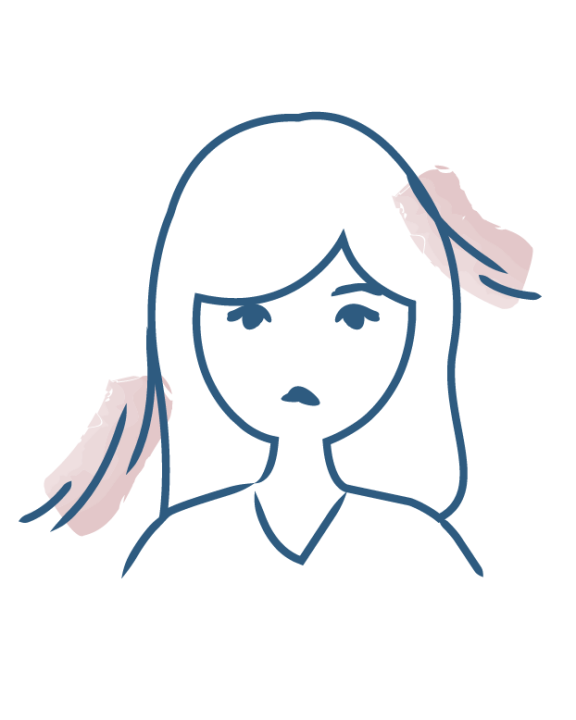The causes of hair loss
Spot baldness and hair loss
- The causes of hair loss
- Hair loss: the impact of iron, zinc, vitamin D, C and B12 deficiencies
- Drug-induced hair loss
- Hair loss and menopause
- Secondary syphilis and hair loss
- Hair loss and hormones
- What is traction alopecia?
- Hair loss and genetics
- Hair loss and fatigue
- Hair loss and the pill
- Hair loss due to stress: reactional hair loss
- Hair loss due to ringworm of the scalp
- Pregnancy and hair loss: everything you need to know
- Scarring alopecia
- Hair loss and Covid
- Spot baldness and hair loss

Spot baldness and hair loss
Spot baldness is a sudden and unexpected loss of hair in patches. It is caused by a reaction of the body against the hair follicles. What are the symptoms of this disease? How can it be treated? Find out here.
Spot baldness, an autoimmune disease that causes hair loss
Hair loss due to spot baldness is a form of alopecia with patches of hair loss that can affect large or small areas of the scalp, sometimes even the entire scalp. It is a common disease, observed in both men and women, at any age. However, it is more frequent in children and adolescents. It affects all ethnic groups: from spot baldness in coily hair to straight hair. It can also affect the eyebrows, the beard or other areas of the body.
Spot baldness is not considered a serious disease, but it can have a significant psychological impact on those who suffer from it. Spot baldness in women often results in a deterioration of self-image and quality of life.
This type of alopecia is caused by an autoimmune disease, that is to say a sudden dysfunction of the body's immune defenses: they identify the hair follicles as a foreign body and attack them, wrongly, to eliminate them. Its mechanism is complex. Scientists don't know exactly what triggers this reaction, or even if it is related to internal factors (due to a virus or hormonal change), external factors (related to something in the environment) or a combination of both. Probably related to genetic factors, autoimmune alopecia is also sometimes seen in people who have been under intense stress.
Spot baldness can occur in people with secondary syphilis, a sexually transmitted infection. Spot baldness during syphilis is not systematic, it is thought to affect less than 1 in 100 patients.
Symptoms of spot baldness
There are several forms of spot baldness:
- The most common form is hair loss in one or more round patches with well-defined contours. Around the patches, the rest of the scalp is normal. The patches can appear on any part of the scalp. Their shape and size are variable (usually a few centimeters in diameter). The skin around the patch appears smooth and without scarring. This should not be confused with ringworm of the scalp, which also appears as patches of alopecia.
- Alopecia areata totalis, rarer, affecting the entire scalp.
- Alopecia areata universalis, the most severe form, characterized by a loss of all hair but also of all body hair (eyelashes, eyebrows, etc.).
The evolution of spot baldness is unpredictable. It can resolve itself spontaneously and never reappear, or on the contrary recur and evolve in episodes of varying intensity and frequency.
Changes in the structure of the nails are also symptoms observed in some people with spot baldness.
Can hair grow back after spot baldness?
It is difficult to predict the severity or duration of spot baldness when it occurs, and even more difficult to know if the hair will grow back or not.
Spot baldness can regress spontaneously with complete regrowth of hair in 6 to 18 months. The regrowth occurs gradually: first regrowth of small white hairs on the patches of hair loss, then the hair thickens and re-pigments. In other cases, on the other hand, the hair loss may become chronic and/or spread.
Some risk factors for non-regrowth of hair have been identified:
- In cases of severe hair loss, especially alopecia areata totalis and universalis;
- If the hair loss starts at an early age, before adolescence;
- When the hair loss is accompanied by nail changes;
- If there is a family history of the condition;
- Or if the person has another autoimmune disease at the same time.
A consultation with a dermatologist is essential to make a precise diagnosis of spot baldness and define the most appropriate treatment.
What treatment is there for spot baldness?
When hair regrowth on patches of spot baldness is not spontaneous, a medical treatment can be prescribed. Most often, it will be based on corticosteroids, either applied to the scalp, orally, or injected into the patch. Minoxidil lotion, used in the treatment of androgenetic alopecia, is also a treatment option for spot baldness.
For more severe and recalcitrant forms, stronger treatments such as immunosuppressants (whose objective is to reduce the action of the immune defenses against the hair follicles) have demonstrated their efficacy.
Camouflage techniques, such as wigs, turbans and scarves, can help better cope with hair loss associated with spot baldness.
More information
- Discover Scarring alopecia
The causes of hair loss
Scarring alopecia
- Discover Hair loss due to ringworm of the scalp
The causes of hair loss
Hair loss due to ringworm of the scalp
- Discover Pregnancy and hair loss: everything you need to know
The causes of hair loss
Pregnancy and hair loss: everything you need to know
- Discover Hair loss and Covid
The causes of hair loss
Hair loss and Covid
- Discover Hair loss: the impact of iron, zinc, vitamin D, C and B12 deficiencies
The causes of hair loss
Hair loss: the impact of iron, zinc, vitamin D, C and B12 deficiencies
- Discover Secondary syphilis and hair loss
The causes of hair loss
Secondary syphilis and hair loss
- Discover Hair loss and menopause
The causes of hair loss
Hair loss and menopause
- Discover Hair loss and hormones
The causes of hair loss
Hair loss and hormones
- Discover Hair loss and the pill
The causes of hair loss
Hair loss and the pill
- Discover Hair loss and fatigue
The causes of hair loss
Hair loss and fatigue
- Discover Hair loss and genetics
The causes of hair loss
Hair loss and genetics
- Discover What is traction alopecia?
The causes of hair loss
What is traction alopecia?
- Discover Drug-induced hair loss
The causes of hair loss
Drug-induced hair loss
Our care routines
Loss of hair density
- Discover MY OCCASIONAL HAIR DENSITY LOSS ROUTINE FOR MEN (LESS THAN 6 MONTHS)
MY OCCASIONAL HAIR DENSITY LOSS ROUTINE FOR MEN (LESS THAN 6 MONTHS)
Are you experiencing loss of hair density?
- Discover MY OCCASIONAL HAIR DENSITY LOSS ROUTINE FOR WOMEN (LESS THAN 6 MONTHS)
MY OCCASIONAL HAIR DENSITY LOSS ROUTINE FOR WOMEN (LESS THAN 6 MONTHS)
Are you losing your hair?
- Discover Anti-reactional loss of hair volume for post-pregnancy and breastfeeding women
Anti-reactional loss of hair volume for post-pregnancy and breastfeeding women
Like many young mothers, you are experiencing some discomfort following your pregnancy?
- Discover MY ROUTINE AGAINST CHRONIC HAIR DENSITY LOSS IN MEN (OVER 6 MONTHS)
MY ROUTINE AGAINST CHRONIC HAIR DENSITY LOSS IN MEN (OVER 6 MONTHS)
Are you losing your hair?
Dermatological expertise
To better understand your skin and hair, discover our exclusive content and innovative care products designed to improve your quality of life..


